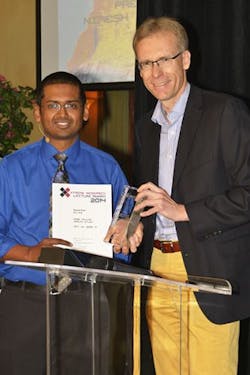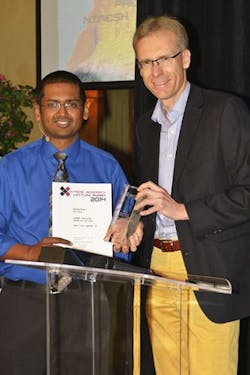OCT system helps discover ocular changes in astronauts
A recent study conducted by the National Aeronautics and Space Administration (NASA; Washington, DC) used Heidelberg Engineering's (Heidelberg, Germany) Spectralis optical coherence tomography (OCT) system on board the U.S. International Space Station (ISS; in low Earth orbit since 1998) to examine ocular changes seen in a number of astronauts. The NASA Ocular Health Study also won the company's annual 2014 Xtreme Research Award, which was presented during a ceremony at the annual meeting of the Association for Research in Vision and Ophthalmology (ARVO; Orlando, FL).
Related: PRODUCT FOCUS: OCT systems for ophthalmology
Dr. Nimesh Patel, an assistant professor at the University of Houston's College of Optometry (Houston, TX) and a consultant to NASA, accepted the award and presented the award lecture. In the presentation, entitled “OCT in Zero G,” Patel explained that 21 U.S. ISS long-duration spaceflight astronauts have developed some or all of the following: hyperopic shift, scotoma, choroidal folds, cotton wool spots, optic nerve sheath distension, globe flattening, or edema of the optic nerve during space flight.
According to NASA, “The purpose of the prospective observational study of ocular health on the International Space Station crew is to collect evidence to characterize the risk and define the visual changes, vascular changes, and central nervous system (CNS) changes, including intracranial pressure, observed during long-duration exposure to microgravity, including post-flight time course for recovery to baseline. This study will gather information that can be used to assess the risk of Microgravity-Induced Visual Impairment/Intracranial Pressure (VIIP) and guide future research needs.”
The study protocol includes pre-flight, in-flight, and post-flight exams with the Spectralis system. During his presentation at ARVO, Patel shared unpublished images and data collected on four astronauts. Confocal scanning laser ophthalmoscope (cSLO) and OCT images showed retinal and choroidal folds not seen on earth-bound individuals. The extent of retinal folds was well visible on transverse section analysis (TSA) of densely sampled Spectralis volume scans. Patel shared his analysis of a hyperopic shift identified through cSLO images—an effect of microgravity seen in 50% of astronauts. Changes to the optic nerve head were studied using Spectralis star pattern OCT scans centered on Bruch’s membrane opening. Bruch’s membrane opening minimum rim width (BMO-MRW) increased by up to 70 μm during space flight and remained elevated at the first post-flight visit in some astronauts, as graphs presented by Patel showed. Potential changes to the peripapillary architecture were studied with OCT circle scans guided by the TruTrack active eye tracking system of the Spectralis system. Multilayer segmentation revealed changes to retinal nerve fiber layer and choroidal thickness that developed during astronauts' stays on the ISS, and remained on the first post-flight visit in some study subjects.
Patel concluded his presentation stating, “With the Spectralis instrument, changes in retinal and optic nerve head anatomy can be monitored in astronauts on the ISS.” He added, “Although there is inter-individual variability, the trends are similar and will provide important insights into the mechanisms involved.”
-----
Don't miss Strategies in Biophotonics, a conference and exhibition dedicated to development and commercialization of bio-optics and biophotonics technologies!
Follow us on Twitter, 'like' us on Facebook, and join our group on LinkedIn
Subscribe now to BioOptics World magazine; it's free!

